The fifth issue of TsODY.RF magazine

Creating a data center: art or craft?
The data center market is becoming the driver of the entire domestic IT industry. Today it has about 100 thousand square meters. m of raised floors, of which about 70-80 thousand. Is in Moscow. Of course, in comparison with Western countries, this is negligible. But it is indisputable that in Russia the infrastructure of data centers has already been created. The accumulated knowledge and experience to make informed decisions.
Gradually fading into the past and times of individual projects. The art of couturier recedes before the casual trend of extras, the main principle of which is convenience and functionality. This trend is becoming more and more evident in the construction of data centers: the process is put on the conveyor.
At first glance, this seems strange - after all, no project to build a data center is like another. Nevertheless, the notorious unification has come to the world of data centers. It makes no sense to argue about whether this is good or bad: after all, every project is not started for the sake of the project itself, but pursues practical goals. Experts approach the construction of a data center rationally: the harmony of a project is verified by the algebra of its budget. And for this purpose, the principles of unification and standardization are adopted.
')
The most fully illustrated of these principles is the modular approach to construction: the December issue of TsODY.RF magazine is devoted to this topic. The installation of a data center from standardized modular structures is becoming a real trend not only in the global, but also in the Russian market.
The most important thing that distinguishes a modular data center from the traditional one is the design, which consists in whole or in part of standard factory-assembled modules. This gives a lot of advantages. Installation of passive wall panels on the site can be carried out as soon as possible: there are examples when, due to the modular principle, the time was reduced from 18 months to 12 weeks.
The modular architecture also makes it possible to deal with the uncertainty of tomorrow. Indeed, in the early stages of the life cycle of a classic data center, its power often exceeds the real need many times over. The center is built with a margin, but the predictable load is rarely achieved, and as a result, the enormous spending on the reserve falls into dead weight.
Yes, and modular data center can be scaled both up and down, whereas in conventional data centers it cannot be done: you will not be able to dismantle the building! The need for operational management at the construction site is also decreasing. The repeatability and reproducibility of a project in constructions is another important aspect of the modular principle. In addition, the experience gained in one project can be quickly replicated to others.
Practice shows that the lack of standards is a direct path to an unpredictable result. And the main problems that lead to a misunderstanding between both sides of the process of creating a data center - the customer and the contractor - are related to the lack of a coherent system of domestic standards applicable to the data center industry. The existing standards for the construction industry cannot close these problems - after all, the issues of forming general requirements for the future data center lie outside the regulatory field of this sphere.
But the data center industry in Russia already exists: the accumulated experience needs only to be aggregated and put into documents. And right now, the domestic industry of data centers is ripe for the preparation of standards. And the first step on this path was the creation of the Association of data center industry participants. The article “Domestic standards of the data center industry: the first step has been made”, in addition to a comprehensive assessment of the situation in the field of standardization of the data center market, discusses the long-term and immediate goals that are currently set by the members of the Association. This independent organization, based on non-profit principles, is open to the entire Russian expert community of data centers.
The issue of the magazine, which the reader holds in his hands, contains a lot of useful information about efficient and inexpensive tools for working with data center assets (article “From Chaos to Order”), network neutrality in action (“Content Delivery: New Principles”). Visiting data centers and engineering companies, we are pleased to note that the experts carefully keep our journal in their libraries, even the very first issues! Readers say that they use the heading “Designing a Data Center” sometimes even as a training tool for young professionals.
Good reading!
Natalya Zhilkina, Chief Editor
The full contents of the issue can be found on the TsODY.RF website .
PS The electronic version of the journal will appear in the first quarter of 2014.
Source: https://habr.com/ru/post/205786/
All Articles